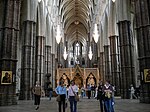Westminster Abbey

Westminster Abbey, formally titled the Collegiate Church of Saint Peter at Westminster, is a large, mainly Gothic abbey church in the City of Westminster, London, England, just to the west of the Palace of Westminster. It is one of the United Kingdom's most notable religious buildings and the traditional place of coronation and a burial site for English and, later, British monarchs. Since the coronation of William the Conqueror in 1066, all coronations of English and British monarchs have occurred in Westminster Abbey. Sixteen royal weddings have occurred at the Abbey since 1100.The building itself was originally a Catholic Benedictine monastic church until the monastery was dissolved in 1539. Between 1540 and 1556, the abbey had the status of a cathedral and seat of the Catholic bishop. After 1560 the building was no longer an abbey or a cathedral, after the Catholics had been driven out by King Henry VIII, having instead been granted the status of a Church of England "Royal Peculiar"—a church responsible directly to the sovereign—by Queen Elizabeth I. According to a tradition first reported by Sulcard in about 1080, a church was founded at the site (then known as Thorn Ey (Thorn Island)) in the seventh century at the time of Mellitus, a Bishop of London. Construction of the present church began in 1245 on the orders of King Henry III.The Abbey is the burial site of more than 3,300 people, usually of prominence in British history: at least 16 monarchs, eight prime ministers, poets laureate, actors, scientists, military leaders, and the Unknown Warrior—the first person interred in the Abbey's Poets' Corner was Geoffrey Chaucer in 1400. As such, Westminster Abbey is sometimes described as "Britain's Valhalla", after the iconic hall of the chosen heroes in Norse mythology.
Excerpt from the Wikipedia article Westminster Abbey (License: CC BY-SA 3.0, Authors, Images).Westminster Abbey
Dean's Yard, London Millbank
Geographical coordinates (GPS) Address Website External links Nearby Places Show on map
Geographical coordinates (GPS)
| Latitude | Longitude |
|---|---|
| N 51.499444444444 ° | E -0.1275 ° |
Address
Westminster Abbey
Dean's Yard 20
SW1P 3PA London, Millbank
England, United Kingdom
Open on Google Maps








